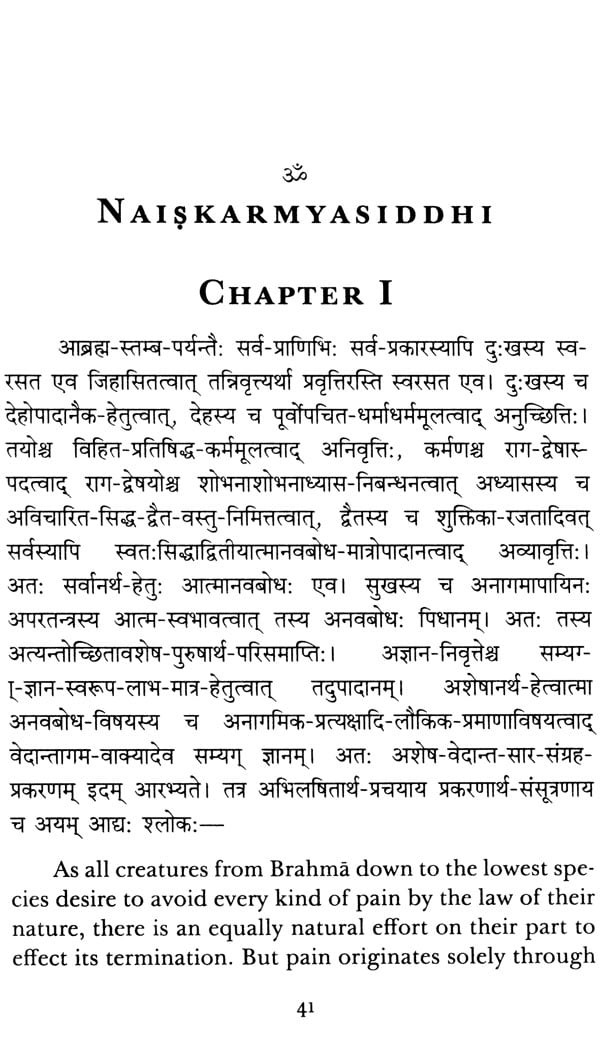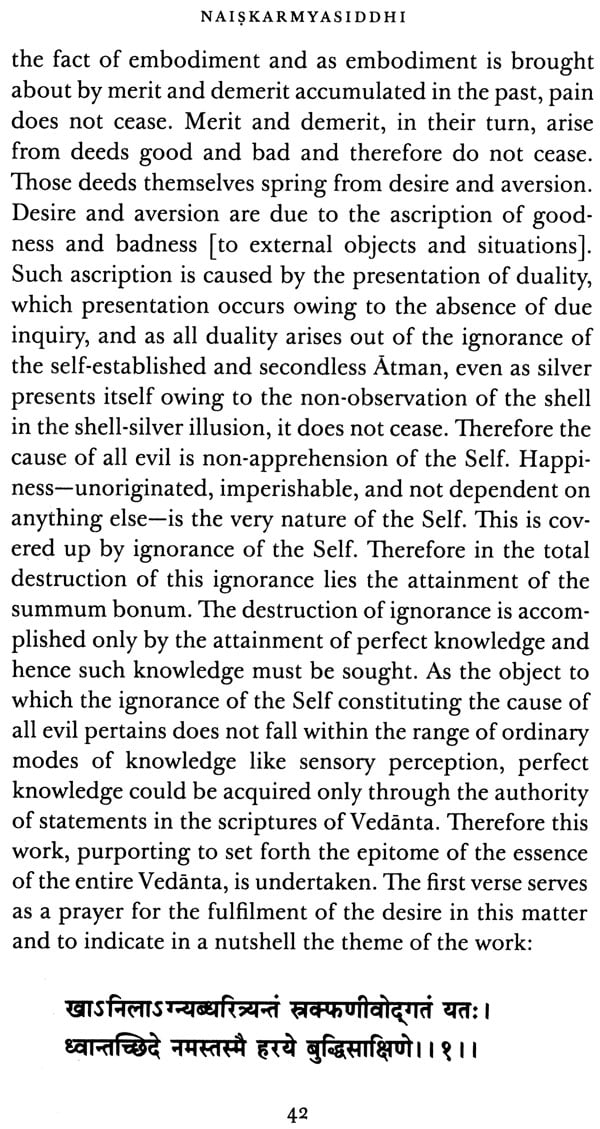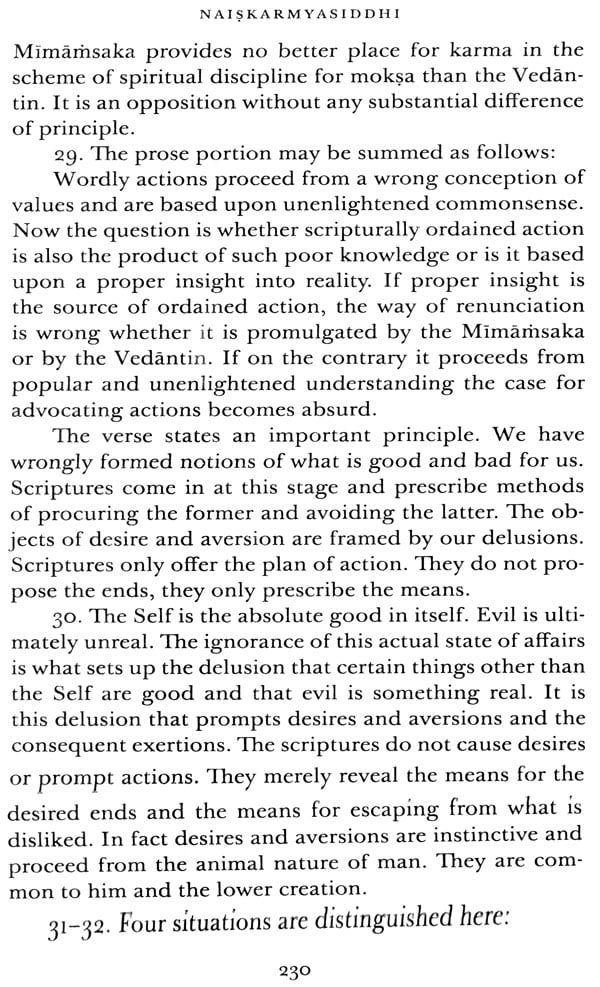
Naiskarmya Siddhi of Sri Sureshvaracharya
Book Specification
| Item Code: | NAY595 |
| Author: | S.S. Raghavachar |
| Publisher: | ADVAITA ASHRAM KOLKATA |
| Language: | Sanskrit Text with English Translation |
| Edition: | 2019 |
| ISBN: | 9788175054943 |
| Pages: | 288 |
| Cover: | PAPERBACK |
| Other Details | 8.50 X 5.50 inch |
| Weight | 280 gm |
Book Description
This book contains the original Sanskrit text, its English translation, and exhaustive notes.
There are four famous Siddhis in Advaita: Brahmasiddhi of Mandanamisra, Naiskarmyasiddhi of Suresvara, Istasiddhi of Vimuktatman and Advaitadsiddhi of Madhusudana. Of these, Brahmasiddhi expounds a special type of pre-Sankara Advaita; Istasiddhi works out the maya doctrine comprehensively and Advaitasiddhi refutes the objections of Nyayamrta, a polemical work of Dvaita. But Naiskarmyasiddhi is a shorter manual embodying the quintessence of Vedanta. According to Col. G. A. Jacob this work is the best of the author's productions. The work is held in such high esteem in the tradition of Advaita that it is quoted not only by every important Advaita writer but also by the critics of Advaita. The author himself says that the work 'purports to set forth the epitome of the essence of the entire Vedanta." (i. I) The term naiskarmyasiddhi occur for the first time in the Bhagavad Gita (xvi- ii. 49). Explaining the meaning of that term Sri Sarikara says: 'The attainment of naiskarmya, the state in which one remains as the action less Self." It is quite possible that this term might have been taken from the Guam for the title of the work.
The quintessence of this text is that jnana, pure knowledge, is the only means for the attainment of Self-realization (i. 99) and not action, however useful it may be as a secondary means. The author quotes seven- teen times from the Upadeiasdhasri of Sri Sankara, not only to emphasize the views of his great master, but also to indicate the authenticity of the tradition.
Suresvara, apart from refuting the doctrine of the Mimarnsakas, has to join issue with three pre-Sankara Advaitins, namely, Brahmadatta, Mandanamisra and Bhartrprapanca. The value of the present work lies in the uncompromising position it takes with regard to pre-Sarikara Advaita. It not only distinguishes it from the views of Sri: Sankara, but also refutes it without mercy.
Suresvara does not agree with the Mimamsaka view that the nityakarmas (obligatory duties) could be the means to liberation (i.21); for their performance has no significance for one who knows himself as the pure Self without a second (i.96). Nor does he admit the view of the Prabhakaras that all significant propositions should refer to some action, for a word may signify an object unrelated to action.
Sri Suresvaracarya is the author of the work, Naiskarmyasiddhi. We know that he was a disciple of Sri Sankaracarya. He himself records this fact in the work and acknowledges the gracious gift of spiritual illumination from this great teacher. He compares the teacher to God Siva, and puts himself down in the place of King Bhagirathi who, according to legend, obtained from the God the sacred river Ganga. He gives pointed expression to his devout admiration for the overpowering greatness of his teacher and expressly tells us that he composed the work in obedience to his instruction.
While so much is certain, we practically know nothing more about his life. That he hailed from the Northern part of India may be gathered from his adverse reference to Dravidians and the reference may also mean that he was not getting on well with the Dravidian disciples of Sankara.' That his life was austere and that it was one of passionate dedication to Vedanta are impressions unmistakably communicated by the spirit and style of his work. A story has gathered round the historical personality of Suresvara in the comparatively late attempts at the biography of Sankara. We are told that he was a celebrated Mimansaka and that as a result of a philosophical debate with Sankara was converted into an ardent and full-fledged disciple of Sankara. His former name is sup- posed to have been Mandana Misra and he is said to have been named Suresvara by his guru after conversion. It is also said that the former disciples of Sankara distrusted the completeness of his conversion and treated him accordingly. In consequence they prevented him from writing a critical exposition of Sankara's commentary on the Brahma-sutra. But Sankara is said to have had great confidence in the new disciple and hence to have commissioned him to write the great works that have come down in his name. In them he is said to have taken particular pains to repudiate his former positions and thus reveal his unreserved acceptance and thorough understanding of the system of his master, in answer to the unfair suspicions of his fellow-disciples. There is nothing incredible in the story as such. Such philosophical conversion, the suspicion of new converts on the part of older adherents and the demonstration of greater zeal and fuller grasp on the part of genuine converts are familiar occurrences in the history of faiths and movements of thought.
Book's Contents and Sample Pages














